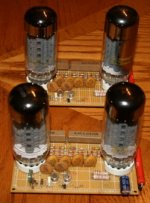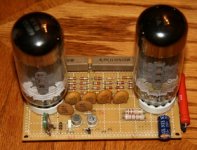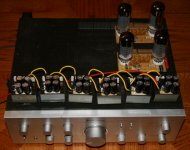After Googling some, it doesn't look to me that specs are the strong point with some of these tubes.
Looking at the specs myself I don't see any problem in using the 6HV5. Actually, I believe it will perform better because the Ra is lower.
If you want to have a look at my amp, well here it is:if you indeed have built one of these beasts.................
HVamp
Dick
After Googling some, it doesn't look to me that specs .......
Sorry I wasn't more clear here,....just meant that from what I was able to come across that info seemed to be somewhat limited. I wonder about pinout compatibility, but it may be a moot point with your guy's custom setups. Dj - Nice looking OTL..... How easy is it to work on though if something went wrong? Do the panels fold out or anything? It definitely looks like you put some time into this one!
How easy is it to work on though if something went wrong? Do the panels fold out or anything? It definitely looks like you put some time into this one!
Sorry I wasn't more clear here,....just meant that from what I was able to come across that info seemed to be somewhat limited. I wonder about pinout compatibility, but it may be a moot point with your guy's custom setups. Dj - Nice looking OTL.....
Indeed, even though I can say I'm pretty well experienced.It definitely looks like you put some time into this one!
How easy is it to work on though if something went wrong? Do the panels fold out or anything?
For servicing this approach is not very handy, nothing folds out.
I had to put everything in this 19" case as I don't have room for 2 seperate ones. Plus everything has to be safe for my children.
As the amp is in a closet under the stairs to the next floor, the noise of the fans can't be heard.
Dick.
Dj - I seem to recall from a past thread that were into developing an all-tube approach. Do you keep the EQ intact or just run the signal straight? I can respect the proprietary nature of the circuit no matter what you're approach and have read about past amps employing an all tube circuit, but never have been able to learn much about them. I think it might be because nobody really knows except the designer.... Wish I could read the language of your website, might learn a thing or two.........sigh.
Wish I could read the language of your website, might learn a thing or two.........sigh.
This is what I have built so far.
To assemble one board doesn't take too much time 2-3 hours.
And there is 4 boards for 2 channels. High voltage supply is cascaded
6 separate transformers each giving 800V. This is actually 220V/12V
step-down transformers put backwards and 12V side in series to
fit 110V input. Well, each transformer will see more than rated 12V
but in my case no overheating. With help of voltage doubler circuit
I was able to get over 800V from each transformer.
Power supply is around 250W, which considering max. allowed
dissipation of the 4 tubes (4x30W=120W) is OK.
To get custom made power transformer cost a fortune.
To assemble one board doesn't take too much time 2-3 hours.
And there is 4 boards for 2 channels. High voltage supply is cascaded
6 separate transformers each giving 800V. This is actually 220V/12V
step-down transformers put backwards and 12V side in series to
fit 110V input. Well, each transformer will see more than rated 12V
but in my case no overheating. With help of voltage doubler circuit
I was able to get over 800V from each transformer.
Power supply is around 250W, which considering max. allowed
dissipation of the 4 tubes (4x30W=120W) is OK.
To get custom made power transformer cost a fortune.
Attachments
Do you keep the EQ intact or just run the signal straight?
RetroAudio, I first tried the amp straight as I also wondered why Acoustat made that EQ filter. The amp sounded way to bright.
This was tried on several ESL (Acoustat, Final700, Audiostatic100) with all the same result.
Hence the reason for this EQ, which is a low pass filter. I made a simple filter (R-C-Pot in series) after the first stage to ground, and with the pot you can adjust the right balance of high/mid of the sound.
On the website there is no information but general stuff.
Sasha, I have a custom made HV xformer, with 2000V secondary on a 250VA core. Paid about 75 euros, =90 US$, for it.
BTW, nice pictures.
Dick.
Dj - that's been my experience as well with the EQ. I have run rough freq. response plots to verify (I was playing around, do my best work that way) and found the low-pass filter as well as the hi-freq boost. The hi-freq adjustment is amazingly touchy and one can tell the difference when the circuit is cleaned up with better components, at least I can. Stats seem to need this EQ in general from what I have gathered. I have heard of others sticking the servo up to other panels and reported it sounded just fine. Of course, some measuring would be needed to get it just right, a capability not everyone has. I don't know, these projects never seem to end cause there's always something left to do.
Sasha - keep up the work! You'll learn things as you go and will be the better designer for it. I think you've undertaken a very respectable project, but please be careful for everyone's sake!
Sasha - keep up the work! You'll learn things as you go and will be the better designer for it. I think you've undertaken a very respectable project, but please be careful for everyone's sake!
The EQ has to be adjusted if an other panel is connected.
On the original servo there are 2 user selectable EQs depending on the distance to the wall at the back of the panels. The main difference is in the low frequencies.
Ofcourse these EQ where designed to suit the 3 panels that came with each of them.
The Hi-freq is mandatory or else the panels will sound to bright.
The original Acoustat servo amp suffer from to slow and outdated op-amps, introducing distorsion with todays high class music sources. Listen to piano for example.
Introducing better components can improve it , but this flaw will always remain unless you do a major circuit update.
Dick.
On the original servo there are 2 user selectable EQs depending on the distance to the wall at the back of the panels. The main difference is in the low frequencies.
Ofcourse these EQ where designed to suit the 3 panels that came with each of them.
The Hi-freq is mandatory or else the panels will sound to bright.
The original Acoustat servo amp suffer from to slow and outdated op-amps, introducing distorsion with todays high class music sources. Listen to piano for example.
Introducing better components can improve it , but this flaw will always remain unless you do a major circuit update.
Dick.
I agree, there's much that needs to be done to make things sound better. Perhaps the stock unit sounded good in it's day, but when I first started listening to one, I wondered what all the fuss was about. It sure didn't line up with all the hype I had been reading about and it wasn't the best sound I had ever heard, but not the most offensive either.
EQ in my setup is going to be via Behringer I am using anyway and
this way should be better than analog filter (hopefully) .
.
Front end is TL074 (quad) with jfet input. Basic circuit, only feedback
resistors (2) and no caps at all.
Main complain about this amp was use of heavy feedback.
I will try to play with it (lower it) as much as possible.
Regardless of distortion, well up to 1% is ok.
As soon as I get my distortion meter (in the mail) I will be able to measure distortion and determine how much to lower the feedback.
In my mind this setup :
1: class-a
2: tube amp
3: no transformer in signal path
4: electrostatic speakers
can't be bad!!!



this way should be better than analog filter (hopefully)
 .
. Front end is TL074 (quad) with jfet input. Basic circuit, only feedback
resistors (2) and no caps at all.
Main complain about this amp was use of heavy feedback.
I will try to play with it (lower it) as much as possible.
Regardless of distortion, well up to 1% is ok.
As soon as I get my distortion meter (in the mail) I will be able to measure distortion and determine how much to lower the feedback.
In my mind this setup :
1: class-a
2: tube amp
3: no transformer in signal path
4: electrostatic speakers
can't be bad!!!
Today I put all together and it was partial success.
Amp is working, good pretty clean swing, but the bias is too low.
Probably because I am using different tubes than original ones.
Also when I play 1K sine there is sound coming from the tubes
like running water and it is pretty loud.
My main problem now is low bias, only 1.5mA instead 5-6mA.
Any advice what to do to increase bias?
Amp is working, good pretty clean swing, but the bias is too low.
Probably because I am using different tubes than original ones.
Also when I play 1K sine there is sound coming from the tubes
like running water and it is pretty loud.
My main problem now is low bias, only 1.5mA instead 5-6mA.
Any advice what to do to increase bias?
sasha - perhaps you're finding out that the tube might not be the best one. If your circuit is correct, then perhaps the tubes have a different transconductance that will allow only what you're finding. That's only a guess , I'm no true expert on tubes. Not sure what else to tell you at this point besides to verify your bias circuit values.
Sasha don't let your first result let you down.
The choice for 6HV5 is a good one, altough I still have to try it.
Your bias is indeed to low, ofcourse because you are using a different tube in the circuit for 6HB5.
What you could try is to increase the G2 voltage by increasing the +150V on the bottom tube. Consequently the upper tube must change to if you use this methode. This can be done by altering the 470K resistor.
The other methode is to lower the G1 voltage on the bottom tube.
This could be done by playing with the 100k collector resistor to the -150V.
Your goal is to have 6mA bias with half of the supply voltage at the cathode of the upper tube.
DJ
The choice for 6HV5 is a good one, altough I still have to try it.
Your bias is indeed to low, ofcourse because you are using a different tube in the circuit for 6HB5.
What you could try is to increase the G2 voltage by increasing the +150V on the bottom tube. Consequently the upper tube must change to if you use this methode. This can be done by altering the 470K resistor.
The other methode is to lower the G1 voltage on the bottom tube.
This could be done by playing with the 100k collector resistor to the -150V.
Your goal is to have 6mA bias with half of the supply voltage at the cathode of the upper tube.
DJ
Hi,
Actually I manage to solve bias problem by lowering G1 voltage on the upper tube.
First I tried with bottom tube but that was no good
because preamp circuit developed distortions with change of 100K
resistor. On top of that I didn't realize that tube I am using is
triode and original one is pentode as "rcavictim" pointed out.
He suggested to connect G2 to cathode and omit voltage divider and
150V to G2 so I did. Now bias is fine.
Next problem was proximity of high voltage lines and feedback line.
This gave me some peaks in output signal when close to max swing.
Silicon should solve that problem.
I remember concern from one member regarding not enough
current produced by output needed for driving speakers on high freq.
Today I watched music signal on RTA to see how much of high freq.
is actually in real (music) signal. I compared 2K and 16K and found that 16K is on average 15-20 dB below 2K which was the strongest
in the spectrum. That means 16K has about 32-100 times less swing.
I hope my math is right. This suggest we should have enough current.
I was able to put 40mA in my tests through dummy load.
As soon as silicon I applied is dry I will try speaker load.
Distortion figures are ok. Only 0.5% THD on full swing (9KVpp) and
3% fully loaded (dummy load).
The rest is coming soon.
Actually I manage to solve bias problem by lowering G1 voltage on the upper tube.
First I tried with bottom tube but that was no good
because preamp circuit developed distortions with change of 100K
resistor. On top of that I didn't realize that tube I am using is
triode and original one is pentode as "rcavictim" pointed out.
He suggested to connect G2 to cathode and omit voltage divider and
150V to G2 so I did. Now bias is fine.
Next problem was proximity of high voltage lines and feedback line.
This gave me some peaks in output signal when close to max swing.
Silicon should solve that problem.
I remember concern from one member regarding not enough
current produced by output needed for driving speakers on high freq.
Today I watched music signal on RTA to see how much of high freq.
is actually in real (music) signal. I compared 2K and 16K and found that 16K is on average 15-20 dB below 2K which was the strongest
in the spectrum. That means 16K has about 32-100 times less swing.
I hope my math is right. This suggest we should have enough current.
I was able to put 40mA in my tests through dummy load.
As soon as silicon I applied is dry I will try speaker load.
Distortion figures are ok. Only 0.5% THD on full swing (9KVpp) and
3% fully loaded (dummy load).
The rest is coming soon.
Good job Sasha !
Your math is right, don't worry.
Don't forget the EQ at the input also attenuates the high freq quite a bit, so the figures at the end are even much lower.
I don't have any problems driving big ESL with long high voltage cable( =even more capacitive load), so it must be right.
BTW, i measured one of those VDR from the original Acoustat X used for protection, and it kicked in at 68V.
DJ
Your math is right, don't worry.
Don't forget the EQ at the input also attenuates the high freq quite a bit, so the figures at the end are even much lower.
I don't have any problems driving big ESL with long high voltage cable( =even more capacitive load), so it must be right.
BTW, i measured one of those VDR from the original Acoustat X used for protection, and it kicked in at 68V.
DJ
- Status
- This old topic is closed. If you want to reopen this topic, contact a moderator using the "Report Post" button.
- Home
- Loudspeakers
- Planars & Exotics
- Tube amp specifically for driving ESLs


